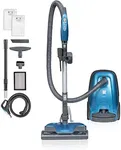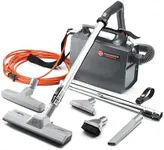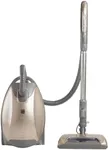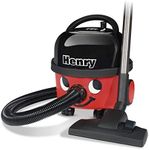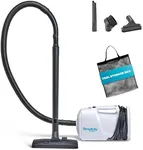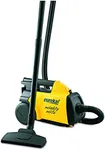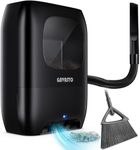Buying Guide for the Best Cylinder Vacuum Cleaners
Choosing the right cylinder vacuum cleaner can make a significant difference in maintaining a clean and healthy home. Cylinder vacuum cleaners are known for their versatility and ease of use, especially in homes with a lot of furniture or stairs. When selecting a vacuum cleaner, it's important to consider various specifications to ensure it meets your cleaning needs effectively. Here are some key specs to look out for and how to navigate them.Suction PowerSuction power is a measure of how effectively the vacuum can pick up dirt and debris. It is usually measured in watts (W) or air watts (AW). Higher suction power means better cleaning performance, especially on carpets and rugs. For homes with mostly hard floors, a lower suction power may suffice, while homes with pets or thick carpets may require higher suction power for effective cleaning.
Filtration SystemThe filtration system determines how well the vacuum can trap dust, allergens, and other particles. HEPA (High-Efficiency Particulate Air) filters are highly effective and can capture up to 99.97% of particles, making them ideal for allergy sufferers. Other types of filters include standard filters and washable filters. If you or anyone in your household has allergies or asthma, a vacuum with a HEPA filter is recommended.
Dust CapacityDust capacity refers to the amount of dirt and debris the vacuum can hold before needing to be emptied. It is usually measured in liters. Larger dust capacities mean less frequent emptying, which is convenient for larger homes or extensive cleaning sessions. For smaller homes or less frequent use, a smaller dust capacity may be sufficient.
Weight and ManeuverabilityThe weight and maneuverability of a vacuum cleaner affect how easy it is to use, especially if you need to carry it up and down stairs or move it around furniture. Lighter models are easier to handle and transport, while heavier models may offer more stability and power. Consider your physical strength and the layout of your home when choosing the right weight and maneuverability for you.
Noise LevelThe noise level of a vacuum cleaner is measured in decibels (dB). Quieter models are more pleasant to use, especially in homes with young children or pets. Noise levels typically range from 60 dB (quiet) to 80 dB (loud). If you prefer a quieter cleaning experience, look for models with lower noise levels.
Attachments and AccessoriesAttachments and accessories enhance the versatility of a vacuum cleaner. Common attachments include crevice tools, upholstery brushes, and pet hair tools. These can help you clean different surfaces and hard-to-reach areas more effectively. Consider the specific cleaning tasks you need to perform and choose a vacuum with the appropriate attachments.
Cord Length and ReachThe cord length and reach of a vacuum cleaner determine how far you can move around without needing to switch power outlets. Longer cords and hoses provide greater flexibility and convenience, especially in larger homes. If you have a large area to clean, look for models with longer cords and hoses to minimize interruptions.
